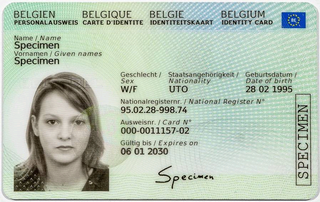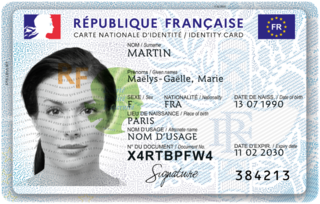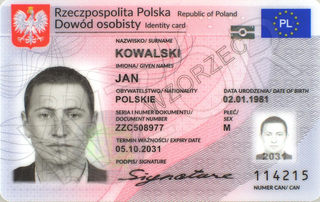An identity document is any document that may be used to prove a person's identity. If issued in a small, standard credit card size form, it is usually called an identity card, or passport card. Some countries issue formal identity documents, as national identification cards that may be compulsory or non-compulsory, while others may require identity verification using regional identification or informal documents. When the identity document incorporates a person's photograph, it may be called photo ID.

A Belgian identity card is a national identity card issued to all citizens of Belgium aged 12 years old and above.

The French national identity card is an official identity document consisting of an electronic ID-1 card bearing a photograph, name and address. While the identity card is non-compulsory, all persons must possess some form of valid government-issued identity documentation.

A Norwegian passport is the passport issued to nationals of Norway for the purpose of international travel. Beside serving as proof of Norwegian citizenship, they facilitate the process of securing assistance from Norwegian consular officials abroad.

The Swedish national identity card is a non-compulsory biometric identity document issued in Sweden. It is one of two official identity documents issued by the Swedish Police, the other being the Swedish passport. It is only issued to Swedish citizens, and indicates the citizenship.

The Estonian identity card is a mandatory identity document for citizens of Estonia. In addition to regular identification of a person, an ID-card can also be used for establishing one's identity in electronic environment and for giving one's digital signature. Within Europe as well as French overseas territories, Georgia and Tunisia the Estonian ID-card can be used by the citizens of Estonia as a travel document.

The Croatian identity card is an identity document issued in Croatia. Any Croatian citizen who is resident in Croatia can obtain an ID card and it is compulsory for all citizens over the age of 18. This document is issued by the police on behalf of the Ministry of the Interior.

The Polish Identity Card is a national identity document issued to Polish citizens. As Poland is a European Union member state it is also serves a European Identity card. Every Polish citizen 18 years of age or older residing permanently in Poland is required to have an identity card issued by the local office of civic affairs. Children as well as Polish citizens living permanently abroad are entitled, but not required, to have one. Identity cards are valid for a period of 10 years.

The Slovak citizen ID card is the identity document used in the Slovak Republic, in addition to the Slovak passport. It is issued to all citizens, and every person above 15 years of age permanently living in Slovakia. It is required by law to hold a valid identity card.

The Bulgarian identity card is a compulsory identity document issued in Bulgaria. The document is issued by the police on behalf of the Ministry of Interior and is the main form of identification on the territory of the Republic of Bulgaria. All Bulgarians are obliged by law to carry their identity cards with them at all times and are subject to fines should they not.

The Swiss identity card in its current form dates back to July 1994. It is in the form of a plastic photocard. It can be used as a travel document when travelling within European Free Trade Association or to the European Union, the European microstates, Georgia, Turkey, and on organized tours to Tunisia.

The Finnish identity card is one of two official identity documents in Finland, the other being the Finnish passport. Any citizen or resident can get an identification card. Finnish citizens will get indication of citizenship on the card. It is available as an electronic ID card, which enables logging into certain services on the Internet, local computers or adding digital signatures into LibreOffice ODF documents or creating DigiDoc formatted containers that also allows encryption during content transfer. ID card is applied at a police station and it is issued by the police.

The German Identity Card is issued to German citizens by local registration offices in Germany and diplomatic missions abroad, while it is produced at the Bundesdruckerei in Berlin.

The Portuguese identity card, is an identity document issued by the Government of Portugal to its citizens. The card replaces several previous documents, including the Bilhete de Identidade, Social Security card, National Health Service card, Taxpayer card and voter registration card, in one secure card. The Citizen Card was first issued in the Azores in mid-2006. However, as of 2017 BIs continued to be issued in some cases.

The Cypriot identity card is issued to citizens of Cyprus. It can be used as a travel document when visiting countries in Europe, as well as French overseas territories, Montserrat and Georgia. This document is not valid in Turkey.

The Slovenian identity card is issued to Slovenian citizens. It can be used as a travel document when visiting countries in Europe, as well as Georgia, French overseas territories, Montserrat and organized tours to Tunisia.

The Luxembourg identity card is issued to Luxembourg citizens. It serves as proof of identity and nationality and can also be used for travel within the European Union and a number of other European countries.

The Greek identity card is the official national identification document for Greek citizens. It is issued by the Hellenic Police.

The national identity cards are identity documents issued to citizens of nations in the European Union (EU) and European Free Trade Association (EFTA) member states, with the exception of Denmark and Ireland. The identity cards have been harmonized as a new common identity card model replaced the various formats in use on 2 August 2021.

The Norwegian identity card, commonly referred to as the national identity card in Norway, is a non-compulsory biometric identity document issued since 30 November 2020. It is one of two official identity documents issued by the Norwegian Police Service, the other being the Norwegian passport. It is only issued to Norwegian citizens, and may indicate citizenship so that it can be used as a travel document facilitating freedom of movement within the European Free Trade Association and the European Economic Area. For travel within the Nordic countries no identity documentation is legally required for Nordic citizens due to the Nordic Passport Union.


















